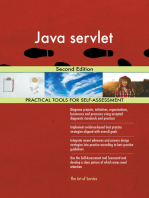10 Basic Spring Boot Questions Every Developer Should Know
Uploaded by
Ashutosh Shashi10 Basic Spring Boot Questions Every Developer Should Know
Uploaded by
Ashutosh Shashi10 Basic Spring Boot Questions:
Every Developer Should Know
1. What is the purpose of the @SpringBootApplication annotation in Spring Boot?
The @SpringBootApplication annotation in Spring Boot is a key element that helps
streamline the setup of a Spring Boot application. It's like a shortcut or a magic wand
that bundles several important settings and configurations into one neat package.
What It Does:
This annotation is a convenience feature that does three major things behind the
scenes:
1. @Configuration: It tells Spring Boot that this class will define some settings or
configurations for the application. For example, you might have configurations
for connecting to a database.
2. @EnableAutoConfiguration : This is where Spring Boot shines. It automatically sets
up the application based on the libraries you have. For instance, if you have
web libraries, it prepares your application to work as a web application.
3. @ComponentScan: It instructs Spring Boot to look for other components, services,
and configurations in the same package as the class with this annotation,
allowing the application to recognize and use them throughout.
Practical Use:
Typically, you place @SpringBootApplication on your main application class. When
your application starts, this annotation triggers Spring Boot to set up your
application with necessary configurations automatically.
Example Code:
@SpringBootApplication
public class MyApplication {
10 Basic Spring Boot Questions: Every Developer Should Know 1
public static void main(String[] args) {
SpringApplication.run(MyApplication.class, args);
}
}
Here, the MyApplication class is marked with @SpringBootApplication . This single line
tells Spring Boot to get busy setting up your application by combining essential
configurations and scanning for components.
2. How do you run a Spring Boot application?
Running a Spring Boot application is quite straightforward. Here's how you do it:
Through the Main Method:
Spring Boot applications are Java applications that have a main method. This is the
standard entry point where the Java Virtual Machine (JVM) starts execution of an
application.
In a Spring Boot application, the main method does something special: it calls
SpringApplication.run() . This method is responsible for bootstrapping the Spring
application context, which is the central hub of a Spring application. It's where all
the magic of dependency injection, configurations, and more happens.
Example:
Suppose you have a Spring Boot application with a main class called MyApplication .
Running it would look like this:
import org.springframework.boot.SpringApplication;
import org.springframework.boot.autoconfigure.SpringBootApplication;
@SpringBootApplication
public class MyApplication {
public static void main(String[] args) {
SpringApplication.run(MyApplication.class, args);
}
}
10 Basic Spring Boot Questions: Every Developer Should Know 2
In this code, @SpringBootApplication is an annotation that sets up various
configurations. The main method calls SpringApplication.run() , passing in
MyApplication.class as an argument, which tells Spring Boot to start this application.
Running the Application:
1. Through an IDE: If you are using an Integrated Development Environment (IDE)
like IntelliJ IDEA or Eclipse, you can simply right-click on the file containing the main
method and select 'Run'.
2. Using a Build Tool: If you're using a build tool like Maven or Gradle, you can use
the command line to run your application.
For Maven, use: mvn spring-boot:run
For Gradle, use: gradle bootRun
Both these methods compile your code, if necessary, and start the Spring application
context, which, among other things, starts an embedded web server if your application
is a web application.
3. What is a Spring Boot Starter? Name one common starter.
A Spring Boot Starter is a special kind of dependency descriptor in Spring Boot that
simplifies the Maven or Gradle build configuration. Starters are essentially a set of
convenient dependency groupings for various types of development in Spring Boot.
Purpose of Spring Boot Starters:
The primary purpose of a Spring Boot Starter is to provide all the necessary
dependencies in one place so that you don't have to hunt down and specify each
one individually.
They help in reducing boilerplate code in your build configuration file ( pom.xml for
Maven or build.gradle for Gradle).
Each starter is tailored to support a specific type of development (web, data,
messaging, etc.) in Spring Boot.
Common Spring Boot Starter:
10 Basic Spring Boot Questions: Every Developer Should Know 3
spring-boot-starter-web: One of the most commonly used starters, spring-boot-
starter-web is used for building web applications, including RESTful applications
using Spring MVC. It provides all the necessary dependencies to build a web
application.
Example with spring-boot-starter-web :
If you're creating a web application using Spring Boot, you can include the spring-boot-
starter-web dependency in your pom.xml (Maven) or build.gradle (Gradle) file. This
starter will bring in dependencies like Spring MVC, Tomcat (as the default embedded
container), Jackson (for JSON processing), and others needed for web development.
Maven ( pom.xml ):
<dependencies>
<dependency>
<groupId>org.springframework.boot</groupId>
<artifactId>spring-boot-starter-web</artifactId>
</dependency>
</dependencies>
Gradle ( build.gradle ):
dependencies {
implementation 'org.springframework.boot:spring-boot-starter-web'
}
By adding this starter, you can immediately start developing your web application
without worrying about individual dependencies and version conflicts, as Spring Boot
manages them for you. It's a key feature of Spring Boot that contributes to its
convention-over-configuration approach, making it easier and faster to get a Spring
application up and running.
4. How does Spring Boot achieve auto-configuration?
10 Basic Spring Boot Questions: Every Developer Should Know 4
Spring Boot's auto-configuration is one of its standout features, making it much easier
and faster to set up and configure Spring-based applications. Here's how it works:
Understanding Auto-Configuration
Concept:
Auto-configuration in Spring Boot is a mechanism that automatically configures your
Spring application based on the jar dependencies you have added. It aims to
reduce or eliminate the need for manual configuration of beans that are commonly
used in Spring applications.
How It Works:
1. Dependency Detection:
Spring Boot looks at the libraries (jar files) in your classpath.
For example, if it sees that you have added a web-related library like Spring
MVC, it assumes you are building a web application and sets up the necessary
configuration accordingly.
2. Conditional Configuration:
Spring Boot uses a series of @Conditional annotations to decide what
configuration should be applied.
For instance, @ConditionalOnClass , @ConditionalOnBean , @ConditionalOnProperty ,
and so on. These annotations help Spring Boot decide whether a specific auto-
configuration class should be applied or not.
If certain conditions are met (like the presence of a specific class in the
classpath), the auto-configuration logic kicks in.
3. Default Configurations with Overriding Capability:
Spring Boot provides sensible defaults for various configurations, but it also
allows you to override these defaults.
For example, if Spring Boot auto-configures an embedded Tomcat server but
you prefer a different server or specific configurations, you can define your own
@Bean for that, and Spring Boot will back off from its default.
Example: Auto-Configuring a Data Source
10 Basic Spring Boot Questions: Every Developer Should Know 5
Imagine you're building an application that interacts with a database. In a traditional
Spring application, you would need to define a DataSource bean, configure connection
properties, set up a JPA provider, etc.
In Spring Boot, if you include a database driver on your classpath (like H2, MySQL, etc.)
and provide database properties in your application.properties or application.yml ,
Spring Boot will automatically configure a DataSource bean for you.
Example of application.properties :
spring.datasource.url=jdbc:mysql://localhost:3306/mydb
spring.datasource.username=myuser
spring.datasource.password=mypass
Spring Boot will use these properties to auto-configure a connection to your MySQL
database. This process significantly simplifies the setup and reduces the amount of
boilerplate configuration code.
5. What is a Spring Profile?
A Spring Profile in Spring Boot is a feature that allows you to define sets of
configurations that can be selectively enabled under different conditions. It's like having
different settings for an application that you can switch based on the environment or
circumstances.
Understanding Spring Profiles
Purpose:
Spring Profiles provide a way to segregate configuration settings for different
environments, such as development, testing, and production.
This helps in managing application behavior under various conditions without
changing the actual code.
How It Works:
10 Basic Spring Boot Questions: Every Developer Should Know 6
You can define a profile in a configuration file (like application.properties or
application.yml ) or with annotations in your Java code.
When the application runs, you activate a specific profile, and only the
configurations associated with that profile are applied.
Example Use-Cases:
1. Different Databases: You might want to use an in-memory database like H2 for
testing but a real database like MySQL in production.
2. API Keys: You could have different API keys for development and production
environments.
3. Feature Toggles: Enable or disable certain features in different environments.
Implementing Spring Profiles
Defining Profiles in application.properties :
You can create multiple application-{profile}.properties files for different profiles.
For instance, application-dev.properties for development and application-
prod.properties for production.
Activating a Profile:
You can activate a profile using the spring.profiles.active property in your
application.properties or as a JVM system parameter.
Example in application.properties :
spring.profiles.active=dev
Or, when running the application:
java -jar myapp.jar --spring.profiles.active=prod
Using Annotations:
You can also define beans for specific profiles in your code using the @Profile
annotation.
10 Basic Spring Boot Questions: Every Developer Should Know 7
Example:
@Configuration
@Profile("dev")
public class DevDatabaseConfig {
// Configuration beans for development
}
@Configuration
@Profile("prod")
public class ProdDatabaseConfig {
// Configuration beans for production
}
In this example, the DevDatabaseConfig class will only be loaded if the dev profile is
active, and similarly for ProdDatabaseConfig with the prod profile.
Spring Profiles are a powerful tool for managing and organizing different configurations
for a Spring Boot application, enabling a clean separation of concerns and making your
application adaptable to various environments.
6. What is the default server port for a Spring Boot application?
The default server port for a Spring Boot web application is 8080 .
Explanation:
When you create a web application using Spring Boot and run it without specifying any
port configuration, it will start up on port 8080 . This means that you can access the
application locally by navigating to http://localhost:8080 in your web browser.
Customizing the Port:
While 8080 is the default, Spring Boot allows you to easily change the server port. This
is commonly done via the application.properties or application.yml file located in the
src/main/resources directory.
Example in application.properties :
10 Basic Spring Boot Questions: Every Developer Should Know 8
server.port=9090
Setting to 9090 would make your application run on
server.port
http://localhost:9090 instead.
Example in application.yml :
server:
port: 9090
Alternatively, you can specify the port directly when running the application:
java -jar myapp.jar --server.port=9090
Or, if you're using Spring Boot with Maven:
mvn spring-boot:run -Dserver.port=9090
This flexibility in configuring the server port is useful in various scenarios, like avoiding
port conflicts with other running applications or setting up different environments.
7. How can you create a custom banner in a Spring Boot
application?
Creating a custom banner in a Spring Boot application is a fun way to add a
personalized touch when your application starts up. By default, Spring Boot shows its
own banner in the console on startup, but you can easily replace it with your own.
Steps to Create a Custom Banner:
1. Create a Banner File:
10 Basic Spring Boot Questions: Every Developer Should Know 9
Make a text file containing the custom banner. This can be plain text or ASCII
art.
You can use online ASCII art generators to create text-based graphics if you
like.
2. Place the Banner File:
Name the file banner.txt .
Place it in the src/main/resources directory of your Spring Boot application.
3. Starting the Application:
When you start your Spring Boot application, it will automatically detect the
banner.txt file and display its contents in the console.
Customizing the Banner Programmatically:
If you want to generate the banner programmatically or pull it from an external source,
you can do so by implementing Banner interface.
Example Code:
import org.springframework.boot.Banner;
import org.springframework.boot.SpringApplication;
import org.springframework.boot.autoconfigure.SpringBootApplication;
import org.springframework.context.ConfigurableApplicationContext;
@SpringBootApplication
public class MyApplication {
public static void main(String[] args) {
SpringApplication app = new SpringApplication(MyApplication.class);
app.setBanner(new Banner() {
@Override
public void printBanner(Environment environment, Class<?> sourceClass, Pr
intStream out) {
out.println("My Custom Banner");
}
});
ConfigurableApplicationContext context = app.run(args);
}
}
10 Basic Spring Boot Questions: Every Developer Should Know 10
Custom Banner Variables:
Spring Boot also supports variables in banner.txt that can be useful to display specific
environment properties, like application version. For instance:
Example in banner.txt :
My Application
Version: ${spring.application.version}
The ${spring.application.version} variable will be replaced with the version number
specified in your pom.xml or build.gradle file.
8. Explain the role of the spring-boot-starter-parent POM.
The spring-boot-starter-parent POM plays a crucial role in Spring Boot applications. It
serves as a parent POM (Project Object Model) for your Spring Boot projects and
provides several key features that simplify Maven configurations.
Key Features of spring-boot-starter-parent :
1. Default Dependency Management:
The spring-boot-starter-parent POM comes with pre-defined configurations for
dependency management. This means it already has versions set for common
dependencies, reducing the need to specify version numbers for each
dependency in your project.
2. Default Plugin Configurations:
It provides sensible defaults for Maven plugins. For instance, it configures the
java.version property to define the Java version for compilation, and sets up
configurations for plugins like maven-compiler-plugin .
3. Spring Boot Plugin Configuration:
The parent POM pre-configures the Spring Boot Maven plugin, which is
essential for packaging and running Spring Boot applications. This plugin helps
10 Basic Spring Boot Questions: Every Developer Should Know 11
in creating executable JARs (Java Archive files) with embedded servers and
other necessary configurations.
4. Resource Filtering:
It includes settings for resource filtering, which can be useful for including
properties files and other resources in your JARs with support for variable
substitution.
5. Inheritance and Customization:
By inheriting from the spring-boot-starter-parent , your project automatically
takes advantage of all these configurations. You can still override or customize
specific settings as needed.
Example:
In your Spring Boot project’s pom.xml , you would typically declare the spring-boot-
starter-parent in the parent section:
<parent>
<groupId>org.springframework.boot</groupId>
<artifactId>spring-boot-starter-parent</artifactId>
<version>2.4.0</version> <!-- Specify the Spring Boot version here -->
</parent>
By specifying this parent POM, your project inherits all the default configurations set by
Spring Boot, making setup and dependency management much simpler.
Benefits:
Simplifies Maven Configuration: Reduces the amount of Maven configuration
needed in your pom.xml .
Standardizes Your Build: Ensures consistency across Spring Boot projects by
providing a standard setup.
Easy to Update: Simplifies the process of updating Spring Boot versions - you only
need to change the version in the parent POM.
10 Basic Spring Boot Questions: Every Developer Should Know 12
9. How do you access application properties in a Spring Boot
application?
Accessing application properties in a Spring Boot application is a straightforward
process, primarily done using the @Value annotation or through configuration classes.
These properties can be defined in files like application.properties or application.yml in
the src/main/resources directory.
Using the @Value Annotation:
The @Value annotation allows you to inject property values into fields in your beans
directly.
Example:
Suppose you have a property in your application.properties file:You can access this
property in a Spring component as follows:
app.greeting=Hello, Spring Boot!
import org.springframework.beans.factory.annotation.Value;
import org.springframework.stereotype.Component;
@Component
public class MyBean {
@Value("${app.greeting}")
private String greeting;
public String getGreeting() {
return greeting;
}
}
Using Configuration Properties:
For more complex configurations or when working with multiple properties, it's more
organized to use configuration classes with @ConfigurationProperties .
Example:
First, define your properties in application.properties :Then, create a configuration
10 Basic Spring Boot Questions: Every Developer Should Know 13
class:In this setup, the properties app.name and app.version will be automatically
bound to the fields name and version in the AppConfig class.
app.name=My Spring App
app.version=1.0.0
import org.springframework.boot.context.properties.ConfigurationProperties;
import org.springframework.stereotype.Component;
@Component
@ConfigurationProperties(prefix = "app")
public class AppConfig {
private String name;
private String version;
// standard getters and setters
}
Advantages of Using Configuration Properties:
Type Safety: @ConfigurationProperties ensures that properties are cast to the correct
data types.
Validation: You can add validation annotations to your configuration class fields.
Grouping: It’s easier to manage and organize related properties together.
Tips:
Property Source: You can define properties in different profiles like application-
dev.properties or application-prod.properties for different environments.
Default Values: With the @Value annotation, you can specify default values using
the colon : syntax, like @Value("${some.property:default}") .
10. What is the use of the @RestController annotation in Spring
Boot?
10 Basic Spring Boot Questions: Every Developer Should Know 14
In Spring Boot, the @RestController annotation is used to create RESTful web services.
It simplifies the development of RESTful web APIs.
Key Points of @RestController :
1. Combines @Controller and @ResponseBody :
The @RestController annotation is a specialized version of the @Controller
annotation which adds @ResponseBody . While @Controller is used to mark a class
as a web request handler, @ResponseBody indicates that the return value of a
method should be used as the response body of the request.
2. Simplifies REST API Development:
When you use @RestController , you tell Spring Boot that this controller is going
to handle REST API requests and should serialize/deserialize service
responses/requests to JSON or XML.
3. No Need for @ResponseBody :
With @RestController, you don't need to annotate each method with
@ResponseBody . It's automatically assumed that all methods will define the
endpoint response.
Example Usage:
Here’s an example to illustrate how @RestController can be used in a Spring Boot
application:
import org.springframework.web.bind.annotation.GetMapping;
import org.springframework.web.bind.annotation.RestController;
@RestController
public class MyRestController {
@GetMapping("/hello")
public String sayHello() {
return "Hello, World!";
}
}
10 Basic Spring Boot Questions: Every Developer Should Know 15
In this example, MyRestController is a REST controller. The sayHello method is
mapped to handle GET requests for the /hello URL.
When a GET request is made to /hello , this method returns a simple string "Hello,
World!" . Thanks to the @RestController annotation, Spring Boot automatically
handles the conversion of this string to a HTTP response.
Use Cases:
Creating API Endpoints: Commonly used to create RESTful endpoints in
microservices or web applications.
JSON/XML Responses: Automatically handles JSON or XML serialization for
response objects, ideal for AJAX or mobile app backends.
To learn more about me visit https://ashutosh.net.in, To explore my published books
visit https://www.amazon.com/stores/author/B08B5DHX7N/allbook and to explore my
courses on Udemy visit https://www.udemy.com/user/ashutosh-shashi-4/. You can also
explore my Medium articles by visiting https://medium.com/@ashutoshshashi. Follow
me on LinkedIn https://www.linkedin.com/in/ashutoshshashi/ and join my WhatsApp
channel https://whatsapp.com/channel/0029Va7WqQ0BadmUz9Fpdu2a to get updates
instantly.
10 Basic Spring Boot Questions: Every Developer Should Know 16
You might also like
- D2, D21, D22, YD22.Differential Relays BROWN BOVERI Brochure100% (1)D2, D21, D22, YD22.Differential Relays BROWN BOVERI Brochure8 pages
- Hibernate Tips - More Than 70 Solutions To Common Hibernate ProblemsNo ratings yetHibernate Tips - More Than 70 Solutions To Common Hibernate Problems257 pages
- Spring Boot Interview Questions and AnswersNo ratings yetSpring Boot Interview Questions and Answers6 pages
- JDevelopers Guide - IBM Java Interview Questions For 3-8 Year ExperienceNo ratings yetJDevelopers Guide - IBM Java Interview Questions For 3-8 Year Experience3 pages
- Learning Spring Boot: Chapter No. 2 "Quick Start With Java"100% (1)Learning Spring Boot: Chapter No. 2 "Quick Start With Java"49 pages
- Junit - Testing Framework For Java: Types of Unit TestingNo ratings yetJunit - Testing Framework For Java: Types of Unit Testing24 pages
- Spring Boot Interview Questions: 10 Step Reference CoursesNo ratings yetSpring Boot Interview Questions: 10 Step Reference Courses18 pages
- Java Information Sheet: Syntax vs. Semantics vs. Style KeywordsNo ratings yetJava Information Sheet: Syntax vs. Semantics vs. Style Keywords8 pages
- 69 Spring Interview Questions and Answers - The ULTIMATE List (PDF Download)No ratings yet69 Spring Interview Questions and Answers - The ULTIMATE List (PDF Download)12 pages
- For HR Rounds, They Will Test Your Analytical Skills and How You Approach Towards ANo ratings yetFor HR Rounds, They Will Test Your Analytical Skills and How You Approach Towards A3 pages
- Java Web Services Interview Questions and Answers: Overview: Integration Styles?No ratings yetJava Web Services Interview Questions and Answers: Overview: Integration Styles?25 pages
- Spring MVC Interview Questions and AnswersNo ratings yetSpring MVC Interview Questions and Answers7 pages
- Interview Question Collection Framework PDFNo ratings yetInterview Question Collection Framework PDF13 pages
- Java Basic Interview Questions: 1. Why Is Java A Platform Independent Language?No ratings yetJava Basic Interview Questions: 1. Why Is Java A Platform Independent Language?32 pages
- 1.1 Try With Resources Enahancements PDFNo ratings yet1.1 Try With Resources Enahancements PDF6 pages
- Spring MVC Hibernate MySQL Integration CRUD Example TutorialNo ratings yetSpring MVC Hibernate MySQL Integration CRUD Example Tutorial17 pages
- Top Spring Framework Interview Questions - BaeldungNo ratings yetTop Spring Framework Interview Questions - Baeldung10 pages
- Java Interview Questions: Difference Between Procedure Oriented and Object Oriented Programming Language?No ratings yetJava Interview Questions: Difference Between Procedure Oriented and Object Oriented Programming Language?62 pages
- Frameworks and Hooks: (Software Engineering Research Lab)No ratings yetFrameworks and Hooks: (Software Engineering Research Lab)18 pages
- Spring Interview Questions and Answers - Spring Framework Training - EdurekaNo ratings yetSpring Interview Questions and Answers - Spring Framework Training - Edureka21 pages
- Sun Certified Enterprise Architect SCEA Mock Exams100% (1)Sun Certified Enterprise Architect SCEA Mock Exams132 pages
- Interview Questions: Etiam Sit Amet EstNo ratings yetInterview Questions: Etiam Sit Amet Est29 pages
- iOS 18 App Development Essentials: Developing iOS Apps with SwiftUI, Swift, and Xcode 16From EverandiOS 18 App Development Essentials: Developing iOS Apps with SwiftUI, Swift, and Xcode 16No ratings yet
- Android Studio 3.2 Development Essentials - Kotlin Edition: Developing Android 9 Apps Using Android Studio 3.2, Kotlin and Android JetpackFrom EverandAndroid Studio 3.2 Development Essentials - Kotlin Edition: Developing Android 9 Apps Using Android Studio 3.2, Kotlin and Android JetpackNo ratings yet
- Github Copilot For Developers: Smart Coding With AI Pair ProgrammerFrom EverandGithub Copilot For Developers: Smart Coding With AI Pair ProgrammerNo ratings yet
- 11th Computer Science Question Bank Volume 1 Tamil Medium100% (1)11th Computer Science Question Bank Volume 1 Tamil Medium49 pages
- Solidworks Api Programming Automation Ebook PDF0% (1)Solidworks Api Programming Automation Ebook PDF3 pages
- Diesel Engines For Alamarin-Jet 180 - 185 Rev3-6No ratings yetDiesel Engines For Alamarin-Jet 180 - 185 Rev3-64 pages
- Real-Time Energy Management System For A Hybrid Ac MGNo ratings yetReal-Time Energy Management System For A Hybrid Ac MG13 pages
- DMB-6100E IP To Analog Modulator User Manual - DigicastNo ratings yetDMB-6100E IP To Analog Modulator User Manual - Digicast26 pages
- Design of An Autonomous Smart Shower With Sensors and ActuatorsNo ratings yetDesign of An Autonomous Smart Shower With Sensors and Actuators17 pages
- Techniques and Tools For The Design and Implementation of Enterprise Information Systems by Angappa GunasekaraNo ratings yetTechniques and Tools For The Design and Implementation of Enterprise Information Systems by Angappa Gunasekara408 pages
- Mazak MR-J2 ABS Repair After Battery FailureNo ratings yetMazak MR-J2 ABS Repair After Battery Failure5 pages
- Ieee Vol. 11, No. 4, 1996: The Bus. EmtpNo ratings yetIeee Vol. 11, No. 4, 1996: The Bus. Emtp9 pages
- LESSON#9 SURGE PREVENTION IN THE CENTRIFUGAL COMPRESSOR - Jeff Lee100% (1)LESSON#9 SURGE PREVENTION IN THE CENTRIFUGAL COMPRESSOR - Jeff Lee42 pages
- Guhan K E&I Engineer & Atex Inspector: Professional SummaryNo ratings yetGuhan K E&I Engineer & Atex Inspector: Professional Summary4 pages
- D2, D21, D22, YD22.Differential Relays BROWN BOVERI BrochureD2, D21, D22, YD22.Differential Relays BROWN BOVERI Brochure
- Hibernate Tips - More Than 70 Solutions To Common Hibernate ProblemsHibernate Tips - More Than 70 Solutions To Common Hibernate Problems
- JDevelopers Guide - IBM Java Interview Questions For 3-8 Year ExperienceJDevelopers Guide - IBM Java Interview Questions For 3-8 Year Experience
- Learning Spring Boot: Chapter No. 2 "Quick Start With Java"Learning Spring Boot: Chapter No. 2 "Quick Start With Java"
- Junit - Testing Framework For Java: Types of Unit TestingJunit - Testing Framework For Java: Types of Unit Testing
- Spring Boot Interview Questions: 10 Step Reference CoursesSpring Boot Interview Questions: 10 Step Reference Courses
- Java Information Sheet: Syntax vs. Semantics vs. Style KeywordsJava Information Sheet: Syntax vs. Semantics vs. Style Keywords
- 69 Spring Interview Questions and Answers - The ULTIMATE List (PDF Download)69 Spring Interview Questions and Answers - The ULTIMATE List (PDF Download)
- For HR Rounds, They Will Test Your Analytical Skills and How You Approach Towards AFor HR Rounds, They Will Test Your Analytical Skills and How You Approach Towards A
- Java Web Services Interview Questions and Answers: Overview: Integration Styles?Java Web Services Interview Questions and Answers: Overview: Integration Styles?
- Java Basic Interview Questions: 1. Why Is Java A Platform Independent Language?Java Basic Interview Questions: 1. Why Is Java A Platform Independent Language?
- Spring MVC Hibernate MySQL Integration CRUD Example TutorialSpring MVC Hibernate MySQL Integration CRUD Example Tutorial
- Top Spring Framework Interview Questions - BaeldungTop Spring Framework Interview Questions - Baeldung
- Java Interview Questions: Difference Between Procedure Oriented and Object Oriented Programming Language?Java Interview Questions: Difference Between Procedure Oriented and Object Oriented Programming Language?
- Frameworks and Hooks: (Software Engineering Research Lab)Frameworks and Hooks: (Software Engineering Research Lab)
- Spring Interview Questions and Answers - Spring Framework Training - EdurekaSpring Interview Questions and Answers - Spring Framework Training - Edureka
- Sun Certified Enterprise Architect SCEA Mock ExamsSun Certified Enterprise Architect SCEA Mock Exams
- Java Reflection Complete Self-Assessment GuideFrom EverandJava Reflection Complete Self-Assessment Guide
- iOS 18 App Development Essentials: Developing iOS Apps with SwiftUI, Swift, and Xcode 16From EverandiOS 18 App Development Essentials: Developing iOS Apps with SwiftUI, Swift, and Xcode 16
- Android Studio 3.2 Development Essentials - Kotlin Edition: Developing Android 9 Apps Using Android Studio 3.2, Kotlin and Android JetpackFrom EverandAndroid Studio 3.2 Development Essentials - Kotlin Edition: Developing Android 9 Apps Using Android Studio 3.2, Kotlin and Android Jetpack
- Github Copilot For Developers: Smart Coding With AI Pair ProgrammerFrom EverandGithub Copilot For Developers: Smart Coding With AI Pair Programmer
- 11th Computer Science Question Bank Volume 1 Tamil Medium11th Computer Science Question Bank Volume 1 Tamil Medium
- Real-Time Energy Management System For A Hybrid Ac MGReal-Time Energy Management System For A Hybrid Ac MG
- DMB-6100E IP To Analog Modulator User Manual - DigicastDMB-6100E IP To Analog Modulator User Manual - Digicast
- Design of An Autonomous Smart Shower With Sensors and ActuatorsDesign of An Autonomous Smart Shower With Sensors and Actuators
- Techniques and Tools For The Design and Implementation of Enterprise Information Systems by Angappa GunasekaraTechniques and Tools For The Design and Implementation of Enterprise Information Systems by Angappa Gunasekara
- LESSON#9 SURGE PREVENTION IN THE CENTRIFUGAL COMPRESSOR - Jeff LeeLESSON#9 SURGE PREVENTION IN THE CENTRIFUGAL COMPRESSOR - Jeff Lee
- Guhan K E&I Engineer & Atex Inspector: Professional SummaryGuhan K E&I Engineer & Atex Inspector: Professional Summary
























































































